#hotel imperial 1939
Text
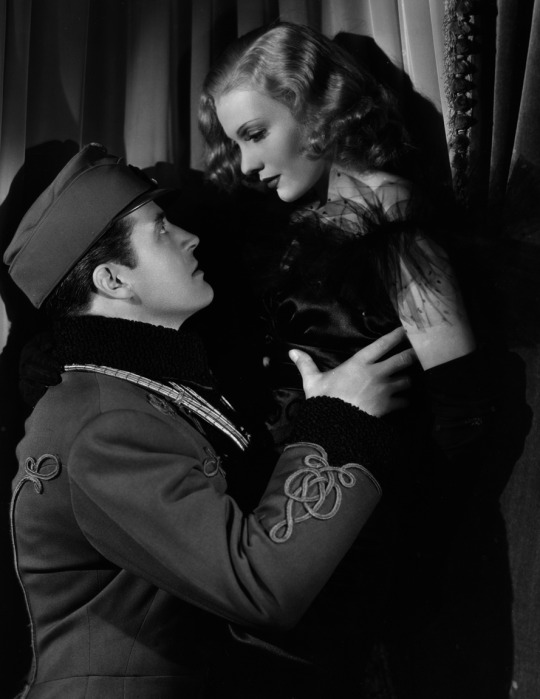
Hotel Imperial (1939): Not a particularly good film, but the two leads (Isa Miranda and Ray Milland) are both so attractive in it I almost don’t even care?
#hotel imperial 1939#classic film#isa miranda#ray milland#they honestly have more chemistry in this promotional photo than they do in the actual film#so much potential and so much of it squandered#(GIRLFRIEND DOESN'T EVEN FIND OUT WHY HER SISTER COMMITTED SUICIDE WHICH WAS HER WHOLE DRIVING IMPETUS WTF!!!)#still they are so pretty and it actually uses some pretty neat dutch angles in a few scenes#konstantya watches more old movies
12 notes
·
View notes
Photo
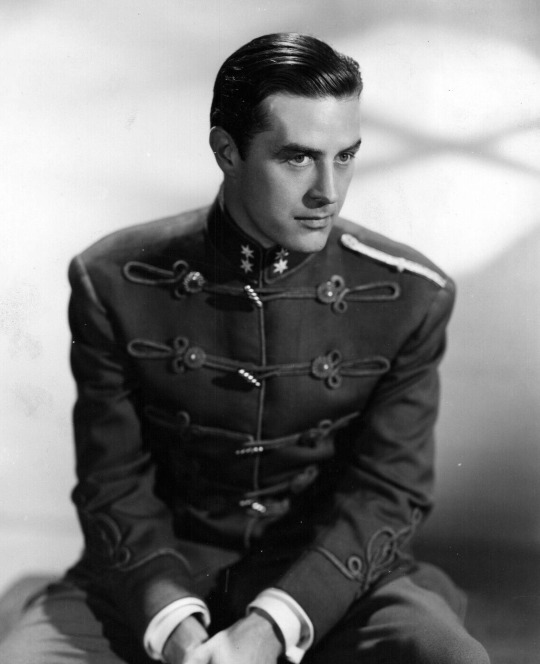
Ray Milland photographed for Hotel Imperial (1939).
91 notes
·
View notes
Note
One day I would to write an essay on how Spain systematically denying Basques, Canarians, Catalans and Galicians their identity and instead calling them "Spanish" and "Hispanic" is a form of imperialism (like... Franco literally attempted ethnic cleasing against non-Castilians, did we all forget this)
Kaixo anon!
Let's not forget, it's true. But it wasn't just Franco, it started way earlier, with the arrival of the Bourbon dinasty to Spain.
The amazigh languages of the Canary islands are thought to have been lost around the late 18th century, early 19th.
1768 SPAIN: New law passed that forces to teach solely in Spanish in Aragón and Catalunya; it was extended to the whole territory in 1780.
1772 SPAIN: Another law banned all merchants to have their bookkeeping in any language but Spanish.
1776 SPAIN: Printing books in Català and Euskara was prohibited.
1789 FRANCE: disappearance of every old regional law and language. Books not written in French were burnt and the use and teaching of any other language was punished.
1794 FRANCE: Education must be solely in French, any other language became prosecuted.
1801 SPAIN: all theater plays and songs in any other language but Spanish became banned. Also dancing to non-Spanish songs.
1803 SPAIN: it's documented the first report of physical punishment for speaking in Euskera at school.
1857 SPAIN: Spanish Grammar and Ortography became the only and mandatory text book at public schools.
1862 SPAIN: Using any language but Spanish in any public document was prohibited.
1867 SPAIN: another law banning theater plays in Català or Euskera.
1876 SPAIN: Basque old laws became banned. According to Madrid newspaper "El Imparcial": "Taking away their old laws isn't enough, we now have to take their language away."
1896 SPAIN: Speaking on the phone or sending telegraphs in Basque or Català became illegal.
1902 SPAIN: Any teacher that taught in Català or Euskera began to be punished.
1903 FRANCE: another law banning Euskera & Català in school.
1923 SPAIN: Euskera & Català became banned from official events.
1925 SPAIN: every textbook not written in Spanish were removed; teachers that didn't teach in Spanish were suspended from work without pay.
1930 SPAIN: Every local institution is forced to keep their visitor's book and registrations only in Spanish.
1937 SPAIN: Prohibition of speaking Basque and every sign of Basque culture, ie using Basque names, playing Basque instruments, wearing Basque colors. The punishments were from social humiliations to jail or execution. Same thing happened in Catalunya.
1938 SPAIN: Only Spanish names accepted. In church, masses just in Spanish, with a permission of only a 10 min. preach in Basque if nobody understood Spanish.
1939 SPAIN: Signs in Euskera & Català in hotels were removed.
1940 SPAIN: Signs in Euskera & Català in justice courts and shops were removed.
1940 SPAIN: Public workers forced to speak just in Spanish or face dismissal. Every movie - national or international - is forced to have its dialogues in Spanish.
1944 SPAIN: Euskera & Català again banned from public documents and even tombs.
1947 SPAIN: Euskera & Català banned from magazines.
1948 SPAIN: Again, Euskera & Català banned from schools.
1954 SPAIN: Euskera & Català banned from every radio station.
1964 SPAIN: It became illegal to feature Euskera & Català in records or advertising.
1978-2015 SPAIN & FRANCE: Still Euskera & Català are unregulated in France, and in Spain in places like Trebiñu.
[we didn't include galego because in the source we use it didn't and we're not completely sure it was included in all these laws, but we're 95% convinced it was too, so.. include it in your heads.]
Source
The Spanish and French governments have tried SO SO SO hard during the last 300 years to erase us. Good thing is we're more stubborn and proud than them.
#euskadi#euskal herria#basque country#pais vasco#pays basque#catalunya#canarias#euskera#euskara#català#galego#galiza#minoritized languages#spain#france#politics#history#anons
196 notes
·
View notes
Text
20th July 2024.
𝐒𝐚𝐭𝐮𝐫𝐝𝐚𝐲 𝟐𝟎𝐭𝐡 𝐉𝐮𝐥𝐲 𝟏𝟗𝟕𝟒. In America, Cash Box had Ma!… at No 113 in the Charts.
𝐒𝐚𝐭𝐮𝐫𝐝𝐚𝐲 𝟐𝟎𝐭𝐡 𝐉𝐮𝐥𝐲 𝟏𝟗𝟕𝟒. In America, Billboard had a short article about Lena, plus a half page advert for her single. In their charts, she was at No 100.
𝐒𝐚𝐭𝐮𝐫𝐝𝐚𝐲 𝟐𝟎𝐭𝐡 𝐉𝐮𝐥𝐲 𝟏𝟗𝟕𝟒. Writing in Sounds magazine, John Peel replied to ‘Gareth of Bristol’, who had railed against John’s snide remarks about Lena and members of the Osmond family on his radio show. The article was reprinted in ‘The Olivetti Chronicles’ published after John’s death.
𝐒𝐮𝐧𝐝𝐚𝐲 𝟐𝟎𝐭𝐡 𝐉𝐮𝐥𝐲 𝟏𝟗𝟕𝟓. Lena starred in Sunday Night at the Blackpool Opera House, rehearsal was at 2.30pm, with the shows at 6.10pm and 8.20pm. she was paid £1500.
𝐅𝐫𝐢𝐝𝐚𝐲 𝟐𝟎𝐭𝐡 𝐉𝐮𝐥𝐲 𝟏𝟗𝟕𝟗. It isn't recorded how The Lena Zavaroni Show went at The Spa Theatre, Bridlington, as next door in The Royal Hall Ian Dury's fans rioted.
𝐒𝐮𝐧𝐝𝐚𝐲 𝟐𝟎𝐭𝐡 𝐉𝐮𝐧𝐞 𝟏𝟗𝟖𝟎. Lena starred in Sunday Night at the Blackpool Opera House. Rehearsal was at 2.30pm and the shows were at 6.10pm and 8.20pm. Her fee was £2000.
𝐒𝐮𝐧𝐝𝐚𝐲 𝟐𝟎𝐭𝐡 𝐉𝐮𝐧𝐞 𝟏𝟗𝟖𝟎. She was photographed at The Imperial Hotel, Blackpool, where she generally stayed when she was in town.
𝐒𝐚𝐭𝐮𝐫𝐝𝐚𝐲 𝟐𝟎𝐭𝐡 𝐉𝐮𝐥𝐲 𝟏𝟗𝟖𝟓. The Dutch press TV pages featured “It’s not where you start, it’s where you finish”, which was going to be broadcast on Nederlands 1 the following evening.
𝐃𝐞 𝐕𝐨𝐥𝐤𝐬𝐤𝐫𝐚𝐧𝐭;
“The Cream of Fame, many children sang on stage in the period that the eponymous television program had a large viewing density. Famous, they all wanted to be. If that was possible through such a fun, swinging American Academy of Fine Arts, then there was little in the way between dream and reality. Later, when Fame had long since disappeared from the screen, aspirations of the young jump-in-the-field melted as quickly as the fame of the American television stars who populated the “school.” Becoming famous had to be done in a different way, through the choir of Children for Children, the Play Back show, Stuif-es-in or something similar. Wasters, not go-getters. And you need perseverance to be famous for at least part of your life as a dancer, singer, actor, star. This is again evident from Between dream and reality, (It’s not where you start…. lts where you finish), a television documentary by Tony Kysh about some former students of the famous English Italia Conti Stage School, which the VPRO broadcasts on Sunday 21 July at 7.20 pm.Kysh visits this London training institute for musical stars, dancers and singers five years after his award-winning film Stars in their eyes, dealing with the real or non-real future expectations of young students. He met pupils of that time, who felt like the cream of Britain, because they worked at the renowned drama school. He has to conclude that Peter Butler — ‘I never dreamed that I would become a soloist there’ — has now become a solo dancer at the Moulin Rouge in Paris; that Jackie Mark celebrated triumphs in the musical Oliver, that Bonnie Langford has the best chance of breaking through completely, after her successes in the musicals Cats and Pirates of Penzance, but that two of the most promising former pupils, Rudi Davies and Lena Zavaroni, have completely missed out.Rudi, daughter of the writer Beryl Bainbridge, regularly speaks with her mother about her development in the last five years. She says that at one point she lost all enthusiasm for the education, that she became a punk and that her mother was ashamed of her when she walked down the street with her. Her mother says it was a terrible period. But Rudi is doing well again. The film shows extensively that she, not without success, auditions at the London Central School of Speech and Drama. It is someone who, after being snapped off, picks up the thread again. Whether she is much happier is doubtful after seeing the final images, when she is listening to a street musician. Lena Zavaroni is certainly not happy. She can’t afford it anymore. She only comes into the picture as the enthusiastic thirteen-year-old she was during the previous documentary. She is now completely turned off and suffers from anorexia, 'an inside cry for help’, as the successful Bonnie Langford calls it. The interviews show again and again how many drops of sweat, enthusiasm, hard work, uncertainty, discipline and commitment are needed to achieve something at school, and certainly also afterwards. Furthermore, you hear that some had the idea that the close-knit club that was the school community would stay together forever and. of course, fell apart. And the viewer sees how much children who entered the school young and full of enthusiasm changed over the years, not only outwardly, but especially internally. , Beryl Bainbridge can not yet say: “When she started she was so incredibly enthusiastic” and seems to miraculously ignore the fact that girls of sixteen, fortunately, can sometimes get interested in other facets of life than just a shiny career in showbiz. The young people who have entered the path to success have soberly talked about their profession full of brilliance and appearances, managers and theatre agents. That makes the film valuable for parents who want to send their children into the theater world and for those who still hope that dreams can effortlessly become reality”. Ruud Gortzak
Photograph; Bonnie Langford: success in Cats and Pirates of Penzance.
𝐀𝐥𝐠𝐞𝐦𝐞𝐞𝐧 𝐃𝐚𝐠𝐛𝐥𝐚𝐝;
From our radio and TV editors. HILVERSUM —
“ Five years ago, director Tony Kysh made the award-winning documentary 'Stars ii their Eyes’ about the Londoi Conti Stage School. Hi then filmed the very young pupils (average* age: thirteen years) of this kleinkunstacademit and talked to them about our future expectations. Last year, Kysl visited a number of students. What was justified in their ambitions? The answer is given in the documentai re 'lt’s not where you start it’s where you finish’, which will be broadcast on Sunday by the VPRO under the title 'Between dream and reality’. The stories Kysh was told varied quite a bit. A number of the interviewees had clearly made it in the harsh theatre world. One of them is, for example, Bonnie Langford, who has already been on stage at musicals such as Cats and The Pirates of Penzance. But there is also another side of the coin. This is evident from the experiences of, for example, Rudi Davies, a daughter of the writer Beryl Bainbrigde, who is the first to q_woord the j 1 in detail. After her training at the wor t Conti Stage School, the red-haired Rudi has no step, more in the direction of the . theatre. It all had to do with a “kind of identity crisis where she landed after her education. ven hed TALENTED gj "At school, I myself was not cattle”, Rudi explains five years later. She was considered one of the most talented students and some of them predicted her a career as Shirley MacLaine. me( But Rudi had no appetite for building a career in the theater. She did not appear at eel auditions, xia she preferred to stay at home. She cut her red hair to the horror of her mother she got a punk hairstyle with the intention to ihocker her surroundings. Her behavior is dictated by her mother to become an adult. A clear connection with the Conti school is not made. At the end, Rudi appears again in the picture, -laar period of self-examination is over and she lives plans conceived to follow ;and other theater training 'e. That will be s Ie London Central School of d Speech and Drama, where she will be admitted after a tough audition. STAR ; For Bonnie Langford, I Ie status as a star has already reached. In England she is considered one of the most important theatre personalities despite her age of nineteen. As a child star, Bonnie already attracted a lot of interest and that has not changed since then. The same was expected of Lena Zavaroni, who as a thirteen-year-old was also predicted a ko- r measurement-like career . But she could not cope with the pressure of publicity. She now suffers from anorexia nervosa. For that reason, she does not appear in the film. Bonnie iin of Lena, describes her illness as an emergency cry. “She wanted to show that she was a normal person, who could also be hurt S.” nr Bonnie, a cheerful ir jump-in-the-field, confesses that she sometimes cannot withstand the tensions . “On the outside side you can still look so fresh and cheerful, but , some things can hurt a lot. Most o people don’t realize that gi. Occasionally I cry li sometimes.” With that statement, Bonnie refers to the image that the she has of her outside the guard and that has been forced on her by the roles she has played so far. They are i would love to play a mean character, in iats of the sugar sweets that she is now being iitiated with. Tony Kish’s film indicates that the road to fame for few is laid away and usually hard The students of Conti School all say that they take this into account. This the images of his documentary turns out the training rather pitis and that the extreme n the students is rlangd. The way in which a singing teacher at a jeven moment a leerg afbekaks, because that tide yawns the lesson, makes it idly that the stars-in; are strong in their shoes to be able to grieve. And after their training it really becomes me”
-TOMORROW: Between dream and reality VPRO 19.20 HOURS NETHERLANDS 1
0 notes
Photo

Cocktail Circles Beverage Set #7190A by The Spool Cotton Company Вязала в подарок к заказу на #Etsy, очень понравилось, наверное, как-нибудь повторю 🙂🤍 Винтажный дизайн, 1939 года. Ссылкой на описание делюсь сегодня в историях и, постоянно - в своем телеграм канале t.me/crochetblog 👌 активная ссылка есть в шапке профиля. ___&____ #салфетка #шеббишикдекор #вязаниекрючком #салфеткаизмотивов #салфеткикрючком #ручнаяработа #салфеткакрючком #ажурнаядорожка #интерьернаясалфетка #питьчайкрасиво #питькофе #шебби #doily #ажурнаясалфетка #декордлядома #салфеткaнастол #декордачи #схемасалфетки #шеббишик #вязанаядорожка #дорожканастол #квадратнаясалфетка #happyhooker #вязанаясалфетка #tischläufer (at Spa Hotel Imperial Karlovy Vary) https://www.instagram.com/p/CkTA8nNokuP/?igshid=NGJjMDIxMWI=
#7190a#etsy#салфетка#шеббишикдекор#вязаниекрючком#салфеткаизмотивов#салфеткикрючком#ручнаяработа#салфеткакрючком#ажурнаядорожка#интерьернаясалфетка#питьчайкрасиво#питькофе#шебби#doily#ажурнаясалфетка#декордлядома#салфеткaнастол#декордачи#схемасалфетки#шеббишик#вязанаядорожка#дорожканастол#квадратнаясалфетка#happyhooker#вязанаясалфетка#tischläufer
0 notes
Photo

☆ 𝗜𝘀𝗮 𝗠𝗶𝗿𝗮𝗻𝗱𝗮 (1909–1982), Italian actress who starred in a few Italian films before landing a contract with Paramount Pictures in the U.S. Billed as "the Italian Marlene Dietrich," she played a femme fatale in a number of Hollywood films, of which Robert Florey's 𝘏𝘰𝘵𝘦𝘭 𝘐𝘮𝘱𝘦𝘳𝘪𝘢𝘭 (1939) was arguably the most successful. | 📷 © Paramount Pictures, 1939 ☆
https://www.instagram.com/p/B4BgC_znXf5/?igshid=12k6wdjxdr5vf
#Isa Miranda#1939#actres#Italy#Italian actress#film actress#Hollywood#Hotel Imperial#Robert Florey#Paramount Pictures#photography#Hollywood film#the Italian Marlene Dietrich#femme fatale#actrice#actrice italienne
28 notes
·
View notes
Photo

Ray Milland and Isa Miranda in Hotel Imperial (1939) directed by Robert Florey
#Ray Milland#isa miranda#hotel imperial#1930s movies#1930s#drama#publicity shot#vintage#kiss#movies#films
477 notes
·
View notes
Text
No Museu de Ciências de Osaka - parte 1 - A visita de Albert Einstein ao Japão em 1922

“Uma vida simples e silenciosa traz mais alegria do que a busca do sucesso em um desassossego constante.” (Bilhete escrito por Einstein em novembro de 1922 e entregue a um mensageiro no Hotel Imperial em Tóquio)
No ano que vem, celebram-se os 100 anos da histórica visita que Albert Einstein (1879-1955), fez ao Japão. O Museu de Ciências de Osaka já se antecipou a data com uma exposição de longa duração que fui conferir de perto e cujas fotos e informações lhes trago agora em primeira mão.

Poucos sabem que Albert Einstein esteve no Japão há quase 100 anos, no final do outono de 1922. Em seu diário, Einstein registrou todas as suas impressões dos japoneses e de sua cultura. Mente aguçada que era, ficou encantado com a arquitetura de Quioto, que definiu como uma das mais “requintadas” que já vira, e considerou os japoneses um povo de “alma pura”, embora inescrutável: “Ninguém pode entender os sentimentos escondidos por trás deste sorriso guardado.” Já quanto ao status de deus do imperador, classificou-o como “muito desconfortável”.

Einstein desembarcou do transatlântico japonês SS Kitano Maru no Porto de Kobe em 17 de novembro com sua prima e esposa Elsa (1876-1936) com grande burburinho, sendo recepcionado por jornalistas, autoridades e uma grande multidão, já que era o cientista mais famoso da época. Antes já tinham passado pelo Egito, Ceilão (atual Sri Lanka), Cingapura, Hong Kong e China, numa longa viagem de quase seis meses que se iniciou em Marselha em 8 de outubro e que se estenderia à Palestina e à Espanha antes de chegarem a Berlim em 21 de março de 1923.

O diário mantido por Einstein nessa sua jornada foi editado por Ze’Ev Rosenkranz e publicado em inglês pela primeira vez em maio como The Travel Diaries of Albert Einstein: The Far East, Palestin & Spain, 1922-1923.

O Japão ainda era considerado uma nação muito atrasada em relação ao Ocidente, daí seus esforços em ser reconhecido como uma potência moderna. Auditórios ficaram lotados para ouvir Einstein expor sua teoria da relatividade por três ou quatro horas seguidas, pacientemente traduzida do alemão.

Já haviam se passado três anos desde que o astrofísico britâncio Sir Arthur Eddington (1882-1944) confirmou a curvatura da luz das estrelas ao passar pelo Sol, uma previsão chave da teoria da relatividade geral de Einstein de 1915, que explicava a gravidade como uma distorção do espaço-tempo. Ele seguiu seu artigo revolucionário de 1905 sobre a relatividade especial, que lançou as bases para sua equação de equivalência de energia-massa: E = mc2.
Cartas e manuscritos originais de Einstein exibidos no Museu de Ciências de Osaka.

Foi durante essa viagem, mais exatamente no dia 13 de novembro, que Einstein recebeu a notícia oficial por telegrama em Xangai de que havia sido agraciado com o Prêmio Nobel de Física de 1921, prêmio esse não pelo trabalho que lhe rendeu a maior fama, a teoria da relatividade, mas por um artigo de 1905 sobre o efeito fotoelétrico. Agora, ele se propunha a unificar as duas grandes forças que governam o universo, a gravidade e o eletromagnetismo, um desafio irresolvido que continua a ser o maior do campo da Física.
Menos de uma década depois, o Japão assumiria de vez o espírito militarista e imperialista invadindo a Manchúria, e Einstein seria forçado a sair da Alemanha pelos nazistas, refugiando-se nos Estados Unidos, que afundaria os navios japoneses que o haviam levado àquele país e o arrasariam com uma bomba atômica cujo terrível poder, por ironia do destino, derivava da própria lei que estabelecera anos atrás como funcionário do escritório de patentes suíço: E = mc2.

A bomba atômica inaugurou uma nova fase na história. Em 26 de janeiro de 1939, o físico dinamarquês Niels Bohr (1885-1962) surpreendeu um grupo de cientistas em Washington ao anunciar que dois alemães do Instituto Kaiser Wilhelm, em Berlim, haviam desintegrado o átomo de urânio. O temor de que os nazistas construíssem bombas atômicas levaram os físicos Enrico Fermi (1901-1954), da Universidade da Columbia, e Albert Einstein, do Instituto de Altos Estudos, junto com outros, a persuadirem o presidente Roosevelt a iniciar um programa urgente que fosse na mesma direção. Todavia, os trabalhos só foram efetivamente iniciados em 1940. As pesquisas em diversas universidades não tardaram a confirmar, no verão de 1941, a viabilidade dos explosivos nucleares.
Einstein e Elsa (sentados em primeiro plano, no centro-esquerdo da foto) posando junto com várias autoridades japonesas.

Einstein, que estudou na Itália e na Suíça, obteve em 1901 a cidadania suíça e, em 1909, foi nomeado professor de Física Teórica da Universidade de Zurique. Lecionou também na Universidade alemã de Praga e em Berlim. Em 1914 começou a dirigir o Instituto de Física Kaiser-Wilhelm. Banido pelo regime nazista em 1933, estabeleceu-se nos Estados Unidos, onde se tornou membro do Institute for Advanced Study, de Princeton, vindo a naturalizar-se norte-americano em 1940. Einstein realizou diversas pesquisas em outros domínios da física, contribuindo na ampliação da teoria dos quanta, no entendimento da transformação da energia nas reações fotoquímicas e na demonstração experimental das correntes moleculares de Ampère. Em 1929 lançou as bases de uma teoria dos campos de força, mas seu renome universal se deve principalmente à famosa teoria da relatividade, de que foi o grande criador, tendo publicado a “teoria especial” em 1905 e a “teoria geral” em 1916. Em 1950 deu a público a teoria do campo unificado, em que procura demonstrar que todas as formas da natureza se regem pelas mesmas leis básicas.

Osaka Science Museum
Endereço: 4 Chome-2-1 Nakanoshima, Kita Ward, Osaka, 530-0005
Assista ao vídeo que fiz no Museu de Ciências de Osaka no meu canal no YouTube:
youtube
7 notes
·
View notes
Text

Isa Miranda and Ray Milland in Hotel Imperial (Robert Florey, 1939)
7 notes
·
View notes
Text
FOMA 35: Albania - Future Stories For The Past
The selection of this Forgotten Masterpieces is developed under the reference of the book Albania - Decades of Architecture in Political Context written by Sotir Dhamo, Besnik Aliaj and Saimir Kristo.
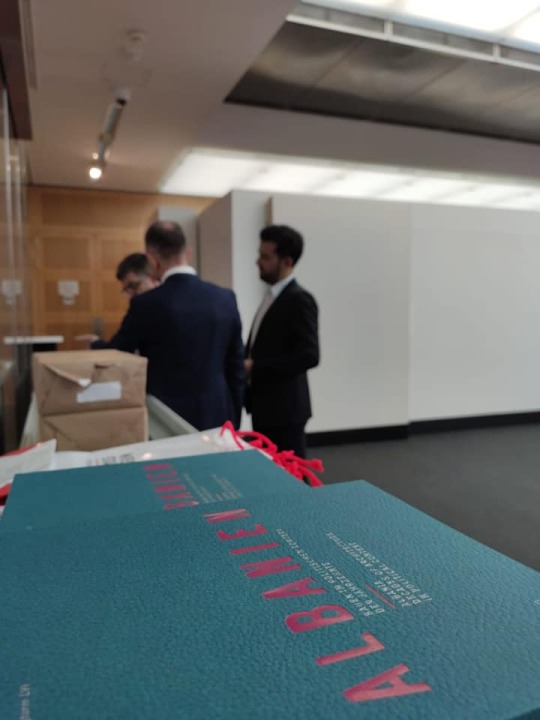
This first volume of FOMA presented by Saimir Kristo include architectures from the administrative and governmental ranks, culture and education buildings, rehabilitation facilities, hotels and hospitalities and remains of regimes.
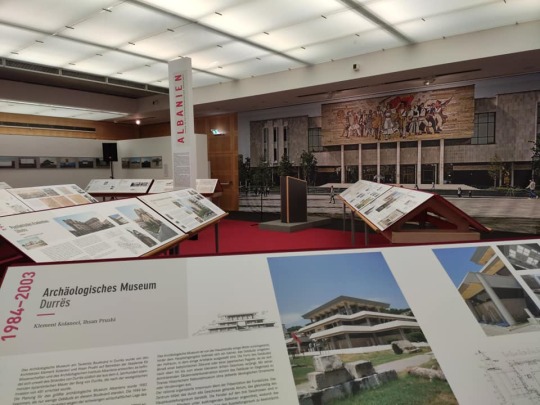
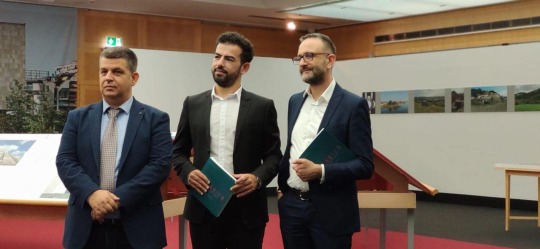
Authors of the book Besnik Aliaj, Saimir Kristo and Sotir Dhamo (from left).
Albanian projects realized between an intense and particular social and political scene involve buildings from the self-declared monarch of King Zog I, to the colony of Imperial Italy under the fascist regime before World War II, up to the rule of the party of labor and the dictatorial regime of Hoxha.

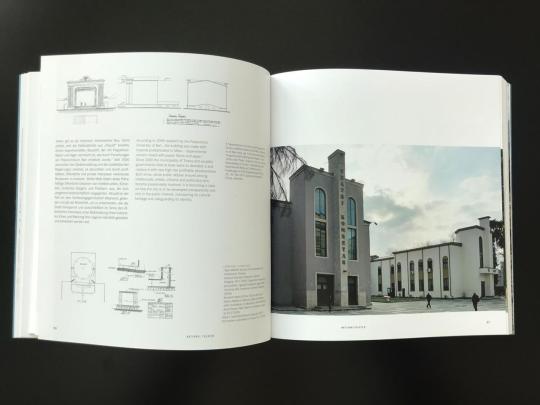
The Royal Villa in Durres constructed by Florestano Di Fausto, Gherardo Bosio, Kristo Sotiri and Armando Brasini was the summer residence of king Zog I and his family. The fashionably styled building has survived as a symbol of the monarchy. According to some sources it was a gift to the king from the business community of Durres, according to another it was given to the king by the Italian government with the intention to strengthen relations between Albania and Italy.
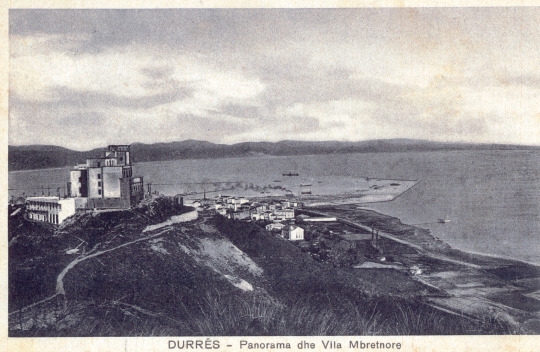

The Royal Villa is situated on top of an adjacent central hill of the city.| Photo via National Technical Archive of Construction Albania
The presence of the kind and his family in Durres, despite his main headquarters in the new capital Tirana, brought about a type of political balance between the two cities and the role they played in the history of the country.
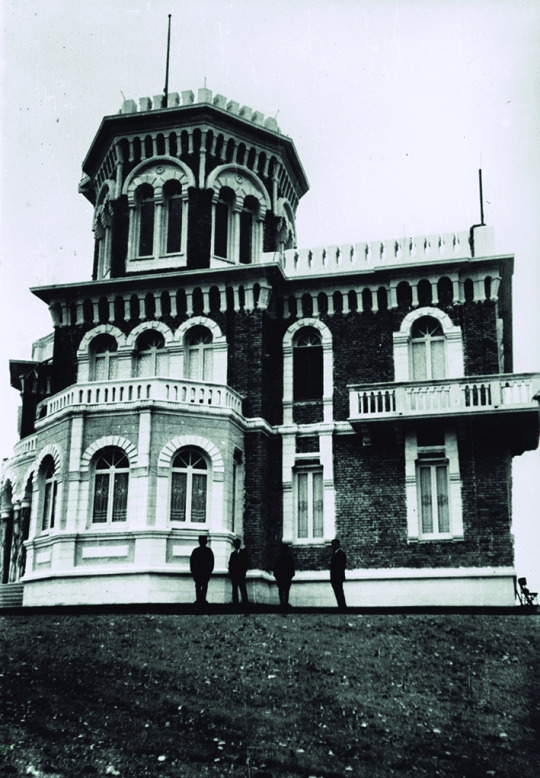
The first concept of the Royal Villa with its own European style was designed by Italian architect Armando Brasini (1929). The final project was finalized by Florestano Di Fausto, assisted by the engineer Antonino Chiesa (1928-1929). Documentation found in the archives show that the original design was in an eclectic style and retained a pre existing structure, which was partially demolished. The intervention of the Italian architect Gherardo Bosio was limited to the interior, transforming the former royal palace into the office of the lieutenant governor as documented in a series of undated sketches.


This building designed by architect Kristo Sotir was later on substituted by the building designed by Florestano Di Fausto. The designs of Bosio and Di Fausto show the dilemma of Italian architects of the 1930s generation, operating between principles of the nineteenth century and rationalism (Giusti, 2006).

With its 360-degree panorama, it offered a view of both, the sea and the land, especially the historic city. Construction of the vila started in 1926 based on the art nouveau concept of the local architect Kristo Sotiri (educated in Padova and Venice) who had previously worked for the Romanina royal family. The works were completed in 1937. After the Italian invasion of 1939 the king and his family were exiled. During World War II and thereafter, the residence was used for government receptions and events. The building was unfortunately looted and damaged during the social and political turmoil of the Albanian rebellion in 1997, and is undergoing a gradual process of reconstruction.

The legibility of this building is based on the contrast of pure volumes on different scales.| Photo via Gizmoweb
The commission for the Dajti Hotel was given to Gherardo Bosio, who was in charge of the General Regulatory Plan for Tirana and the detailed design of the Viale dell’Impero, today Martyrs of the nation Boulevard (Bulevardi Deshmoret e Kombit). Bosio situated the hotel at the boulevard’s crossing with Lana River, where the most representative buildings of the capital stood.

Decaying hotel, hidden behind trees on main boulevard. | Photo via Wikipedia
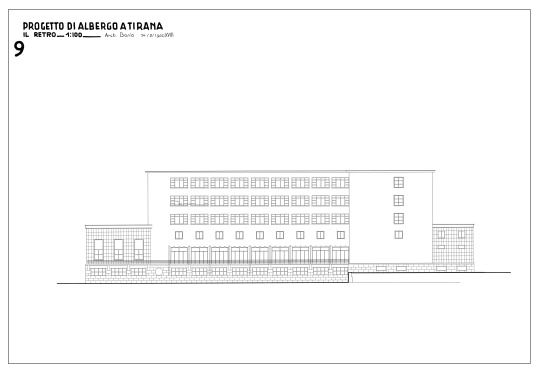

Hotel Dajti just after construction. | Source © Florian Nepravishta, AQTN
The hotel has to follow the design criteria of all the other buildings along the boulevard. Based on the urban regulations issued in January 1940, those criteria concerned primarily the volume, the continuity of the facades and their front length based on multiples of 4-meter modular distances, building width in proportion to road width and the stone cover of the base areas to give them a dignified appearance.
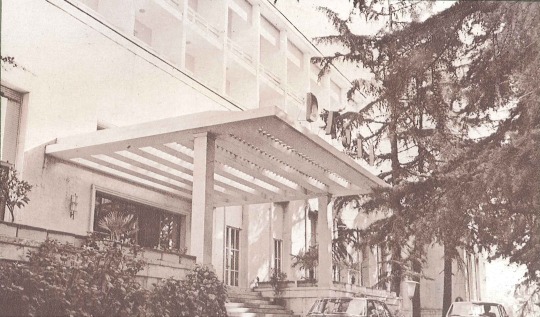
Bosio designed the hotel using a restrained and elegant architectural language. The legibility of this building is based on the contrast of pure volumes on different scales: first, this contrast is created by the distribution of the main corps containing the main programs of the hotel, and on a smaller scale, by carving solids and voids such as balconies and loggias at the level of facades.

Enver Hoxha in front of Hotel Dajti, Tirana 10.7.1945 | Photo via Albanian History
A large staircase covered by a shelter, which bears the hotel sign, marks the entrance. While the base part is of marble, the upper body is plastered. To enhance and animate the appearance of the boulevard, the opening of continuous loggias on the top floors was advised.
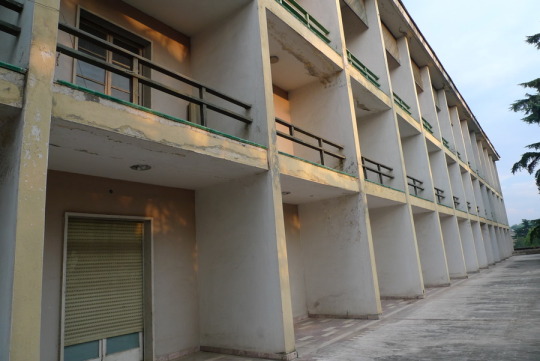
The hotel is not in use anymore today. | Photo © Thomas Haemmerli
The interior, especially its public areas, reveal the complete modernity of the project and its elegance, which is characterized by rational organization of the spaces and clear legibility of the structures. The main hall impresses with light coming from the front and evokes a sense of eternity. Its double volume, supported by pillars, gives an impression of spatial grandeur.


City Logs exhibition by STEALTH.unlimited at the Hotel Dajti during the Tirana International Contemporary Art Biannual. | Photo © STEALTH.unlimited
On the left side of the hall a staircase leads to the upper floor. The gallery overlooking the mezzanine, used for management offices, is clearly visible. The hotel also contains a basement with services, including a late-night bar internally connected with the ground floor bar.
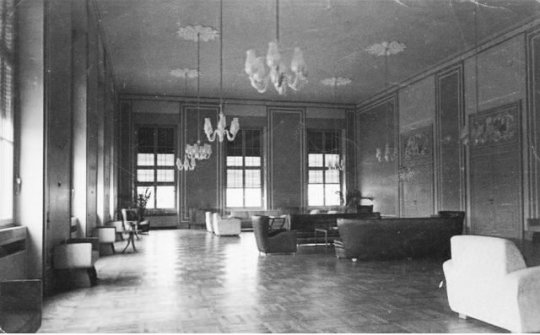

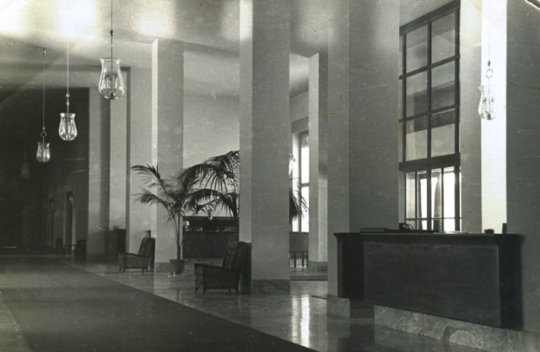
The furnishing parts of the Dajti Hotel, designed in the early 1940s, were designed by Gio Ponti. | Source © Florian Nepravishta, AQTN
Dajti Hotel had everything it takes to be considered an avant-garde hotel. of that period. According to Giusti (2006), the area covered by this building that hosted, on one side, the new hotel and on the other, the offices of the Banca Nazionale del Lavoro, had a surface areas of 2000 m2. If we include atriums, parks and courtyards, the total area amounts to 12000 m2. Gazeta Tomori (in Giusti 2006) states that with i91 rooms and 125 beds, running water, bathrooms and all other amenities including a lift and dumbwaiters, Dajti was one of the largest hotels in the Balkans and the most modern in Europe.

The National Theatre of Albania, built by the construction company Pater Costruzioni Edilizia and the Italian architect Giulio Berte, was completed in 1940. The project was part of the Italian strategy during the occupation of Albania between 1939 and 1943. Two main parallel buildings formed the complex, divided by a half-patio for relaxing, with a pool in the middle and a gym at the front end of the building. The architecture of the complex was based on the principles of the ventennio, as the twenty years of Mussolini’s regime in Italy are called. Initially, the left building was used as the Savoia Cinema for films, theatre and concerts.

The technical infrastructure was entirely suitable for cultural and public events because the building materials offered perfect conditions for acoustics and light technology. It was therefore for a long time also used for meetings and conferences. Albanians could here admire Greta Garbo, Laurence Olivier, Alida Valli, Anna Magnani and attend performances by the composers such as Vivaldi, Paganini, Chopin, Schumann, Verdi, Bellini and Donizetti, not to mention those of the most popular Albanian artists of that time.

The parallel building was the main headquarters of the Skanderbeg Foundation, which undertook several studies and important applications and the forerunner of the Academy of Sciences of Albania under the motto Pro Cultura. Communist authorities use the complex for public show trials or governors accused of collaborating with other enemies. The professional Theatre of the state was located in the building until June 1991 as the Teatri Popullor (People's Theatre).
After the fall of dictatorship, the theatre building was neglected due to the lack of financing. Recently it is in the center of a citizen movement called The citizen’s alliance for the theatre, which is fighting to prevent its demolition from a political campaign that is stigmatizing the building as Fascist and built of poor-quality materials. According to the 2008 research by the Polytechnic University of Bari, the building was made with materials prefabricated in Milan composed of experimental cement mixed with poplar fibers and algae.
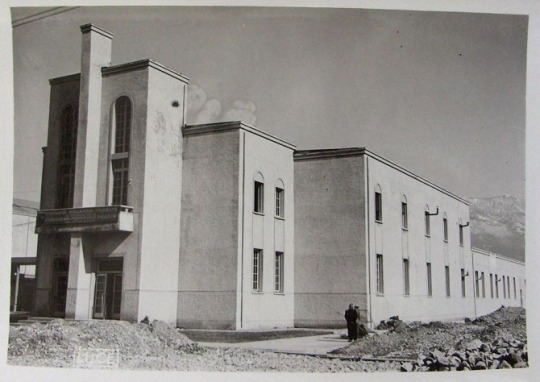
The building after construction. | Photo via Balcanicaucaso
Since 2000 the municipality of Tirana and socialist governments tried at least twice to demolish it and replace it with new high rise profitable developments. Both times, tense public debate ensued among intellectuals, artists, citizens and politicians who became passionately involved. It is becoming a case on how the city need to be developed transparently in the public interest and maintaining its cultural heritage and identity.

Actors in Albania have stormed the country’s national theatre to protest government plans to demolish the iconic building. | Photo via Teatri Kombëtar
Health-care facilities and hospitals are an architectural typology developed in Albania from 1958 to 1988. A number of different hospitals were erected in response to the needs of the country. General hospital centers were established in Berat, Gjirokastra, Tirana and Vlora, infectious disease units in Elbasan and Tirana, obstetrics and gynecology hospitals in Fier, Shkodra and Tirana, pediatric hospitals in Durres and Korce, neuropsychiatric hospitals in Elbasan, Shkodra and Tirana.
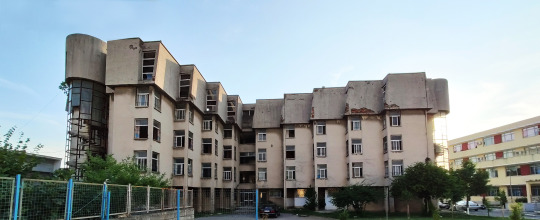


Known as the Psychiatric Hospital of Shkodra, the ensemble was designed in 1982 by Agim Myftiu and Mergim Cano. It is located in the north-eastern part of the city. The floor plan has the shape of a cross, with continuous staggered surfaces on the external perimeter but also in its interior spaces. The space is based on a repeated module consisted by a one room accommodating for patients.

Window openings that allow natural light are placed near the corners of the staggered volumes, creating a unique atmosphere different from that of conventional hospitals. That supports the recovery process of the patients. This particular way of staggering the facade opens new possibilities for the architectural composition of health-care facilities. The service block, developed as a strict volume, is a separate unit positioned on one side of the ensemble with a corridor connecting the two spaces.
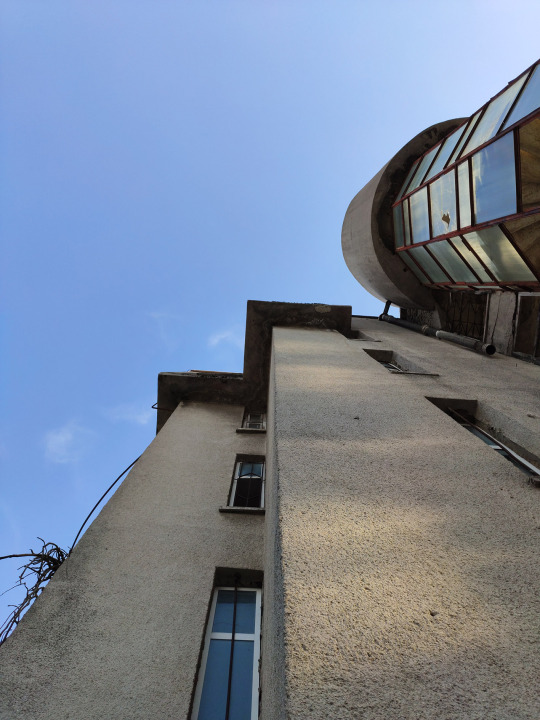
The main entrance placed in the centre of the volume connects also several service entrances for the medical and administrative staff and in such way offers direct access to the various units. Apart from the main block of stairs in the service unit area, all floors accommodating patients are connected with stairs that are positioned in free-standing transparent cylindrical glass volumes. In the basement, apart from the heating and cooling systems, an underground refuge was built, a measure that was commonly taken during the dictatorship period to provide civilians with protection in case of attack.
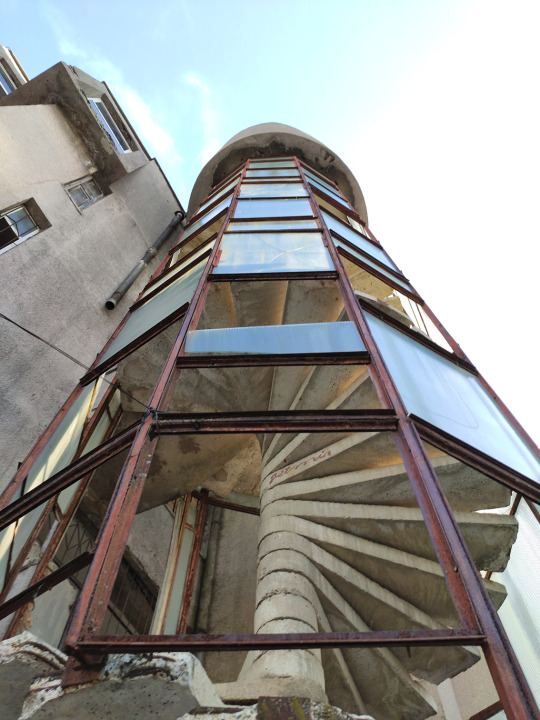
The main characteristic of Tirana’s city center is its monumentality with administrative, cultural buildings and public institutions concentrated along the main boulevard. In 1985, a pyramid building was erected on a former park, today known as Pyramid Square.

The Pyramid of Tirana was meant to house the legacy of the Albanian dictator Enver Hoxha. Four young architects were assigned to design the Enver Hoxha Museum. Klement Kolaneci, Pranvera Hoxha, Pirro Vaso and Vladimir Bregu had to respond to the urgent request to design a monumental new structure with potential sacral character to commemorate for eternity the dictator. The names are not completely occasional since among them are the daughter and the son in law of the dictator.

Designing a building, which was supposed to embody a sacral character, fulfill principles of social-realism and experiment with innovative forms proved to be quite a challenge. Before the project was selected, several alternatives that used the shape of the communist state as their main inspiration, resulting in designs that were too formal and naive were presented. Architects not only drew sketches, but built clay models to assist their understanding of the volumetric relationships.

The Pyramid’s location on the Tirana’s main boulevard between two iconic buildings, the Prime Minister’s office and the Dajti Hotel, required great sensitivity from architects. The architecture would need to respect the existing context of the boulevard and at the same time present a lithic echo of Mount Dajti, which has always been an important natural element of Tirana. Architects combined the socio-realistic principles (star shape, symmetry, processional stairs, raise into a pedestal, etc.) with a pure and articulated form attributing a modern aspect to the building.

The inclined façade of the Pyramid created an illusionary perspective, a unique feature at that time. The placement of the glass windows follows a radial composition around a central axis of rotation. The architectural volume rises 21 meters in height but appears lower due to the inclined planes throughout its exterior, series of platforms and stairs that lead from street level to the entrance. All that allow human scale to prevail. An inclined platform and an underground floor enable an additional entrance on the eastern side. Seen from above, the octagonal umbrella of the façade front is reminiscent of an eagle-wing shape. According to architect Pirro Vaso, architects’ main objective was to create impressive architecture while function played a secondary role. Consequently, architects didn’t choose a grid structure with separated floors but used an open plan, allowing later transformations of the interior space of 17,000 m2.
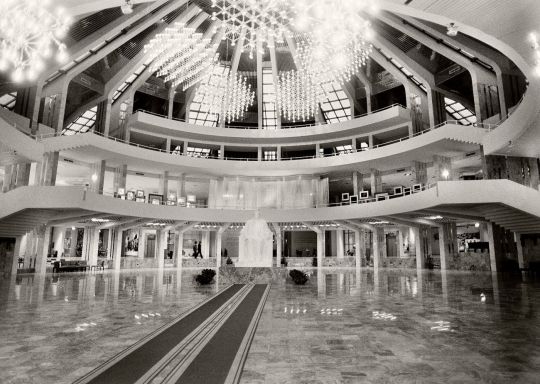
A marble statue of Enver Hoxha in the 1990s.| Photo © Barry Lewis/Corbis
High-quality imported materials and numerous expensive types of marble which covered the exterior and the interior of the Pyramid reveal the symbolic and ideologic importance this building had for the politburo in Albania. Over 4 million dollars are said to have been spent on this building in the 1980s, a time when the poverty level in the country was at its peak. The interior was designed to draw attention to the statue of the dictator, carved in pentelikon white marble (the same marble used for the construction of the Parthenon), at the center of the circular pyramid, which, like the statues of the gods in ancient Greek temples, was to demonstrate a divine presence, enhanced by the communist star on top.

The floor levels are designed as a series of platforms jutting out from the circumference and creating a big amphitheater with a white marble statue of the former dictator at its center. | Foto via Albania Pyramids
The characteristic structure allowed natural light to enter from all sides of the building as well as from a cupola at the very top filtering additional light through its glass cover. The realization of this structure was important not only due to its design and technological achievement but also because it expressed ideological and typological archetypes, such as the linear window development and the lack of vertical walls. As such, this project represents a conceptual shift in Albania at that time. The Pyramid served as a Museum for the dictator from 1988 until 1991. After the fall of the communist regime, the Pyramid was used as an exhibition and fair hall and the square in front became a venue for different public and private events until it was abandoned.
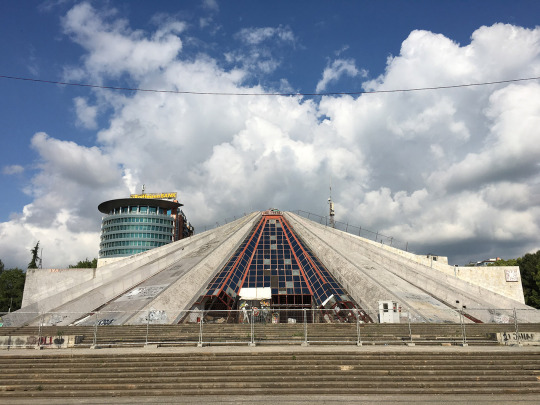
In 1992, the pyramid became the National Cultural Centre, while the square in front of it started to be perceived as a public space and was used by the citizens, becoming at the same time a main tourist attraction. Only after 2000 a discussion regarding the future of this monument began, from change of its function to a preservation as a living provocation reminiscent of the communist period and of course a demolishment.

The Pyramid in 1990s. | Photo via Universal Pictorial Press
However, it was decided to preserve it with a process of renovation that never came to an end. An international competition in 2007 proposed a transformation of the building into a drama theatre and center for the visual arts. Another competition from 2010, won by Coop Himmelb(l)au, proposed a demolition and exchange of the pyramid with a new parliament building in its place. None of the proposals has been realized. A public debate, petitioning and many protests took place in front of the building putting an end to the project and keeping the Pyramid on its place. Instead it become a ground for many experiments including competitions organized by Tirana Architecture Weeks. Lately, a new proposal for the Pyramid was presented by MVRDV intending to convert the former museum of the dictator into a new center for technology, art and culture.
-
Literature:
Giusti (2006), Albania. Architettura e Citta 1925-1943, Maschietto
Vokshi (2014), Tracce dell’architettura Italiana in Albania, DAN Editrice
Hotelet para 1990, zhvillimi i tipologjise ne Shqiperi, Thomai, F., Nepravishta, O Borici, Shtyp Flesh, 2019.
Spiro Mehilli: Botime mbi trashegimine historike te Tiranes.
Aurel Plasari: Mbi Teatrin Kombetar, Lapsi.al 02.07.2018
Spitalet Veshtrim tipologjik mbi arkitekturen shqiptare 1945-1990, Islami, Thomai, Marsida Tuxhari
Xh. Kristo (2018), “Healing Spaces” Architecture space as regeneration of senses”, Diploma Thesis, POLIS University, Tirana
Tirana – city of colours, sto Journal – aRK Magazine, UK, 2018
Interview with Pirro Vaso, “Enver Hoxha” Museum, The Pyramid, 04.2019
Të njihemi me Laureatët e Cmimeve të Republikës, Ndërtuesi Magazine Nr 83, Albanian Ministry of Construction, 1985
Kastriot Dervishi: Historia e Shtetit Shqiptar 1912-2005; Organizmi shteteror, jeta politike, ngjarjet kryesore, ligjvenesit, ministrat dhe kryetaret e shtetit shqiptar. (2006)
Dipartimento di Scienze dell'Ingegneria Civile e dell'Architettura (DICAR), Politecnico di Bari, Italy, VGL, A.B.Menghini, “Experimental building techniques in the 1930s: the ‘Pater’ system in the Ex-Circolo Skanderbeg of Tirana.”, 2013, Epoka-University, Tirana.
S. Kristo, J. Dhiamandi, Albania is NOT an Island. The experimental framework of spatial and architectural interventions in Albania’s capital. ARCHITHESE, Architectural Journal.
All Photos (except the captioned) by © Saimir Kristo, Sonia Jojic, National Technical Archive of Construction, Albania
---
#FOMA 35: Saimir Kristo

Saimir Kristo is a practicing architect, urban designer, lecturer and a Vice-Dean at the Faculty of Architecture and Design POLIS University. His PhD research was focused on city morphology, urban catalysis and public-ness, linked with his experience as the Director of several Regulatory Plans in Albanian cities supported also by USAID. Saimir is an alumnus of the International Visitor Leadership Program by the State Department of the USA and member of civil society. He is a dedicated cultural ambassador into enabling inter-cultural dialogue and collaboration between academia, culture institutions, museums, artists and community developing a common platform for discussion. He curated the two most important architecture and design events in Albania, Tirana Architecture Week 2014: Visioning Future Cities and Tirana Design Week 2015: Design NOW! He was selected as European Young Curator in the CEI Venice Forum for Contemporary Art Curators. He is an international critic and writer and board member of A10 new European Architecture Cooperative, FORUM A+P, Future Architecture Platform and organizer of PechaKucha Night Tirana. He is also a board member of Fundjavë Ndryshe Foundation, a philanthropic foundation that aims to diminish poverty in Albania devoting his skills as an architect building new homes or restoring old houses for Albanians in extreme poverty.
30 notes
·
View notes
Text
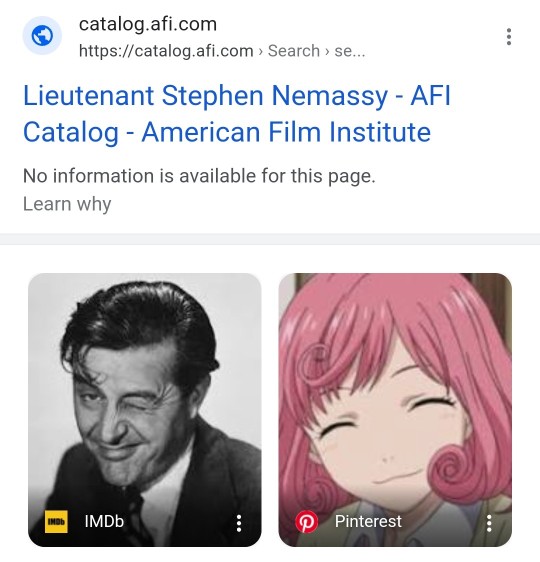
Tfw you run across two wildly different images, from two wildly different eras and mediums, that still manage to have a surprisingly similar vibe.
#ray milland#sorry i don't know the anime gal#still on a#hotel imperial 1939#kick (because it truly is such a bizarre mess of a film)#and looked up the name ''nemassy'' to see what its origin might be and found this instead pfft#(milland's character's name is stephen nemassy#but upon further research it seems maybe they were going for the name ''nemesey''?#the character is a hungarian cavalry officer in wwi and is actually called paul almasy in the 1927 version#not sure why they changed the name for the remake but there you have it)
2 notes
·
View notes
Photo

Ray Milland photographed for Hotel Imperial (1939).
30 notes
·
View notes
Text

Isa Miranda in publicity photo for Hotel Imperial (1939)
3 notes
·
View notes
Text
A making of Deutschland report from an extra.
It was January, the weather was bad, I was driving somewhere by car and the phone rang. The screen showed: Albert Neumann P1945. With Albert, we've known each other for years and our groups, namely Die Freiwilligen and Pomerania 1945, work quite closely together.
- Dietmar? I heard in the phone.
- Listen, I have a tip from a friend in Germany and there is a chance to play in a music video, the video is being shot in Berlin in two weeks for a well-known rock band from Germany... 8 people from your group are needed.
- Which band?
- I can't tell you...
- C'mon Albert, just tell me, if it's a band beginning with "R"?
- Don't tell anyone, nobody! Because I'll rip your head off and nothing will come out of it! The rest will find out when they're on a bus.
- We're going!
The rest of the events unfolded quickly, earlier plans, arrangements, holidays, family parties, etc. - everything ceased to have any meaning and was thrown out of our calendars. Six of us: Dietmar Kuptz, Rene Grzenkowicz, Szymon Poredo, Thomass Woerle, Tomasz Wylamowski and Arkadiusz Telak decided in a few seconds - we're going. From Pomerania 1945 present were Albert Neumann, Francesco Giacomelli, Jan Majewski, Szymon Szewczyk, Henryk Kaźmierczak and Bogumił Gierlotke.
First we travelled to Poznań, where it was confirmed that the music video was indeed for Rammstein. Then we travelled further, to the unforgettable Amadeus hotel in Berlin.
We were taken by a bus arranged by the film crew.
I do not need to add that we were integrating with the only sounds appropriate for such a trip, and the most often repeated sentence was: "I wonder what the video will be about". We did not know what to take with us when it comes to the equipment, so we took everything. For some, it meant taking some large bags and suitcases full of uniforms and props out of the house.
On the set (first day the filming took place in the ruins of a monastery) we went early in the morning and quite quickly understood why filming is considered so exhausting:
it means waiting, waiting and even more waiting.
After many hours we finally got a message – dress up. Initially, we thought that we would play only German soldiers - we were prepared for that - but we learned quite quickly, that if we want, we can play completely different roles and characters. And here we experienced the first shock:
it turned out, that the movie will include medieval monks, Polizei special forces, medieval knights, DDR era uniforms...
That's all we saw, being on the set and changing costumes. The question remained, how (and if) the band puts it together in a sensible whole. We had various theories: maybe it will be a narcotic vision of someone who mentions the past, maybe deathbed memories of a passing life, thoughts and hallucinations of a dying soldier...
The black beauty was equally mysterious – first we saw her in the knight's armor, which in itself provoked questions.
"Are we making a fantasy movie?" Our suitcases still contained German uniforms from the Second World War.
We worked until late night. In addition to the scenes in the old monastery (we played the role of monks), we also took part in scenes in a real, now closed prison in the center of Berlin (the role of rebellious prisoners).
I must say that the prison scenes were quite exciting and they gave much joy at the same time. Thus, when we returned to the hotel in the morning, we were frozen and very tired - just like the members of the band, who were on set until the very end.
Next day in the morning we heard that men in SS uniforms are needed, we changed our clothes into the WW2 ones and marched on with the film crew to the military beat: Links! Links! Links! You would have to see Till Lindemann's face expression as he saw us marching in full uniforms...
The set was located in an abandoned factory and here another comes another curiosity - those of us who knew the previous activity of the director of the video (Specter), knew he was the founder of Aggro Berlin label, immediately recognized this characteristic place with the music videos of German rappers such as SIDO, FLER or B-TIGHT.
After a while, we experienced a real shock. In the middle of the square, where the movie set was located, there was a gallow with four nooses. When one of our colleagues saw that, he said out loud what everyone thought: "I've been in reconstruction for years, I've been on many re-enactment's but it was never THAT hardcore."
At the time, while filming the hanging scenes, we did not know what role they would play in the whole video, but we knew one thing - nothing is simple and unambiguous in Rammstein's work.
We could be sure that this is a controversial provocation, which ultimate goal was to force the viewer to think about the scenes he had watched, but we still had no idea in which context the scenes that were so brutal and that showed the worst moments of German history would be used.
During the shooting of those scenes, we got a bit closer to the band - it was cold, so during the breaks and while warming hands at the fireplace, Till offered everyone... Absolut vodka.
The fire - and the fiery water - bring people closer...
This was also the case this time. Thanks to such small gestures, we will remember the work on the set as an amazing experience.
The members of the band behaved like ordinary people, they were even slightly annoyed by their harassing assistants. It turned out that the recordings will not end in the announced two days, and will be continued until late night. However, it was time for us to go home.
The bus engine was warming up. Some of the colleagues, including the guys from Pomerania, stayed on the final recordings. They were shooting pictures of a big battle, on a huge battlefield, burning at the stake and riots in unspecified time in one of the German cities.
In the night, when burning bus was glowing (scene from the riots), about 3AM in the morning, Specter shouted "We got this, thank you everyone!", people shouted, cheering and rewarded the team with an applause. Both the film crew and the team thanked the participants with a handshake, in person!
Before we left, we looked around looking for the band members. When the vocalist Till Lindemann passed us, we were speechless, he was dressed in knight's armor, pierced with a few swords - his look combined with fatigue on his face made an electrifying impression on us.
We got autographs, wishes for safe travel and we went home in a messy way, in fact, we do not really believe in what we've experienced in the last two days.
While going to the set, we were quite confused and didn't know what to expect, on the way back we were completely lost. How do we put everything together?
What is the meaning of all this? We tried to make various hypotheses, referring to the song "Deutschland" which was released played several times on the set (yes, we heard the song already in January), but still we could 't come up with a coherent story. We had to wait until the premiere.
The atmosphere became dense a few days earlier when the band released the teaser into the scene - as it turned out later, that was closing the 9-minute music video. As you know, the media heated up, Rammstein was accused of ridiculing the Holocaust, disrespecting the historical approach, and even insulting the memory of the victims. On March 28 at 18.10, after watching the music video, everything became clear.
The band once again used people's tendency to generalize and reproduce stereotypes. The video turned out to be a unique depiction of the German history, a country which the lyrical subject "cannot give his love" - among other things due to the difficult past of the homeland.
We won't hide that most of our colleagues are die-hard Rammstein fans, and the participation in the recording for "Deutschland" music video was the greatest adventure in our lives! We built a monument for the rest of our lives, and even posthumously...
It was a nice surprise to see our names in the final credits of the music video. In addition to our two groups, the music featured our colleagues from historical re-enactment groups: Dragoner, Bellum, Maienburg152IR, Rogatywka 1918-1939 and Erhard M17.
They played the role of soldiers of the imperial German army from the First World War.
Found on Rammstein Belgium FB.
97 notes
·
View notes
Text
Kismet (Chapter 16): A BTS Jin imagines fanfic
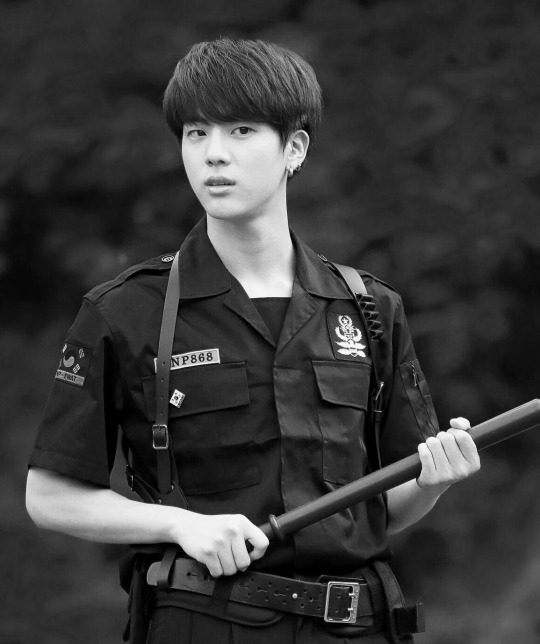
First ever fanfic. Contains fluff and smut. Please read sequentially as it is a long story arc. Please provide feedback! My IG is btskismet.
November 4, 1944
He arrived at Ichihara with nothing but a duffel bag filled with a few clothes and some food. He was not expecting to be on the road for so long after the ship ride from Gyeongseong* to Tokyo. He knew that volunteering to be part of the Army was stupid but if it would help earn money for his family, he would do it. He also knew that he had the know-how to go up the ranks. His father, being a local official in Gyeongseong in the past, knew that if his youngest son learned Japanese, he would go far. Being in a country that has been under Japanese rule since 1910, his father had good foresight to get his son to learn Nihonggo well.
His mother tried to stop him from leaving and she cried so much when he boarded the ship. “Omma, I’m doing this to make you proud of me. Where else can I earn good money?”, he thought to himself silently as he watched his mother and brother from the ship deck. His father passed the year before and he was hoping he was watching his son from the heavens and pleased with his decisions to take care of their family. He knew that his older brother Jun-ha would’ve done what he could but after the incident, his leg would not last if he went with him.
Kim Jun-seok hoped that he wouldn’t be drafted to work in the Army hospitals or worse, to be sent for active duty somewhere else. He was hoping that with his act of volunteering, he would be able to handle technical work the camps or hangars. After all, volunteers can be part of the extensive apprenticeship for technical work, if they are lucky. He was crossing his fingers and praying that luck would shine on him.
“Sakurai Touma!”, a man called his name as he was waiting in line. In 1939, his family had to change their last name to Sakurai and they had to adopt Japanese first names too. Though he and his family still called each other by their Korean names, it would be deemed atrocious, if not illegal, for them to use it outside. To prevent from being ostracized in their town by the Japanese officers and the community, they had to get used to responding to their Japanese names.
He approached the table where the “Gocho” (Corporal in Japanese) was. His heart was beating fast as he was concerned about what assignment he was going to give him.
The stern-looking man scrutinized him and asked for his documents and identification. He looked at his ID, then his face and then back again to his ID and documents. He was afraid that this man might just decide to send him to active duty, especially since the war efforts were more rampant now that Japan has taken a desperate push to continue its hold on several Southeast Asian countries after attacking Pearl Harbor in 1941.
He hoped though that his Japanese language level and family history may keep him in Ichihara, Chiba to work in the Imperial Japanese Army Air Service hangar as an air technician. He was fascinated with the fighter planes made by the Japanese for the war, despite his biases towards the Japanese people in general.
However, he always remembers what his father said to him before he died: “If you follow their footsteps but know in the deepest of your heart that you are Korean, you are not being a traitor to your country. You are merely protecting yourself and your family to live long to fight for Korea in time.”
“Sakurai-san, are you a hardworking man?”, the Corporal asked him in Nihonggo.
“Hai!”, he shouted as a response. He excitedly shared to the Corporal in Nihonggo his desire to work in the Imperial Japanese Army Air Service and what he studied in school that will help him become a good air technician.
“Have you ever seen a fighter plane up close before?”, the Corporal asked pointedly. Jun-seok opened his mouth to speak but didn’t say anything. He realized with that question that he has not seen one in real life. What he saw were drawings and photos of them in school and in newspapers.
“You disappoint me, Sakurai-san. How can you work on combat aircraft if you haven’t seen one at all?”, the Corporal said, swaying his head.
“I have worked on cars and other machines, Gocho! I can be of use to the Imperial Army Air Service! I know what is needed to repair planes to make them work better and stronger to fight our enemies!”, he confidently said.
The Corporal was quiet for some time and was checking his logbook. He then encircled a portion of the page he was looking at. He looked again at the documents and ID Jun-seok gave him.
“You are Kim Jun-seok, yes?”, the Corporal asked him, looking at him intently.
He was taken aback by his question. He stammered and didn’t know what to say. Finally he replied: “My name is Sakurai Touma.”
The Corporal smiled and read a piece of paper that was tucked inside his logbook. “Kim Jun-seok, youngest son of Kim Man-seok and Kim Mi-sun. Younger brother to Kim Jun-ha. Studied in Keio University. Your father worked in the Chosun Hotel and eventually became a banker for the Bank of Korea. He then got elected as Shicho (Mayor) of Seongbuk-gu and was respected by the community and was considered as a kokumin (Japanese national).”
He stared at the Corporal, aware that his mouth was wide open with surprise. He closed it and was stunned to hear the Corporal tell him his family’s background.
“Your father was a great citizen of our nation... but we both know he shouldn’t have allowed those men treat him the way they did.”
He bowed his head. He was trying his best to fight back the tears as he remembered his father.
Kim Man-seok (called Sakurai Makoto in Japanese), didn’t allow three men, who beat him up profusely, to be prosecuted by the Japanese courts. His brother, Kim Jun-ha, was with their father when they attacked and his left leg was fractured when one of the men hit it with a lead pipe.
These men, who were part of the Korean rebel factions, almost killed him when they branded him as a “Chinilpa” or “pro-Japanese”. The Japanese military intervened anyway and had the men executed.
Despite his protests, Kim Man-seok was not able to prevent their deaths. He knew that his father was heartbroken when they died and he couldn’t understand why, even after they beat him and his brother up badly.
“They were misguided, son.”, he remembered his father saying to him. “They thought we support the Japanese but all I wanted us to protect our family. If we didn’t follow them, we would starve and die. They were fighting a war with the Japanese that would be done eventually. They just had to strive and survive because it would be over soon. If we live, we get to fight another day.”
He felt then his father was a coward for acting the way he did - both to the men who hurt him and to the Japanese. It made him feel conflicted for weeks.
The Japanese officials lost faith in Kim Man-seok afterwards. They thought he was defecting by showing compassion towards his attackers. Because of this, they stripped him of his role as Shicho of Seongbuk-gu. He died months later from his injuries.
“Ahem...”, the Corporal cleared his throat and this brought Jun-seok back to reality and he looked up. “Sakurai-san, I know you are not like your father. You are a great citizen to our nation and you will serve us well if I send you to the hangars of the Imperial Air Service. But...we need you somewhere else.”
He started signing a piece a paper in front of Jun-seok. “We have a troublesome town to deal with and we need their land to build tarmacs for our fighter planes. It is a prosperous town and Shosa (Major) Kimori is good friends with their mayor. But our Korean forces there are giving the locals a hard time and Shosa Kimori is having difficulty intervening. He doesn’t want to execute the minimal troops we have there for their insolence and we need to secure that town for resources.”
“We haven’t found anyone who has a high level of language skill in Nihonggo and is also Korean to be sent to intervene and deal with these soldiers. You are perfect and I have been waiting for you to arrive so you can be sent there to help our Shosa and our country for our greater glory.”
The Corporal gave him a big sneer as he shoved the paper in Jun-seok’s hands. Jun-seok blinked twice and looked at what was written.
He was definitely not going to stay in Ichihara and he wasn’t going back home. It would be another two days before he would see land again.
--- to be continued ---
*former name of Seoul
2 notes
·
View notes